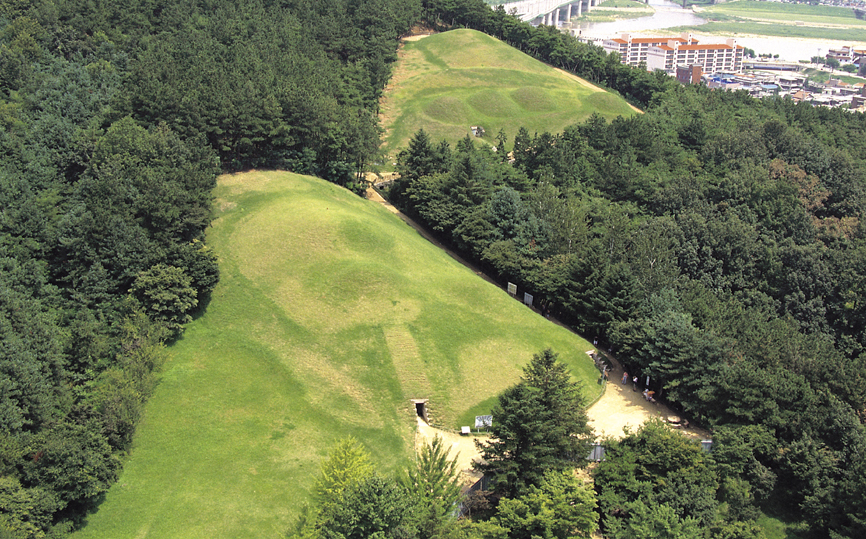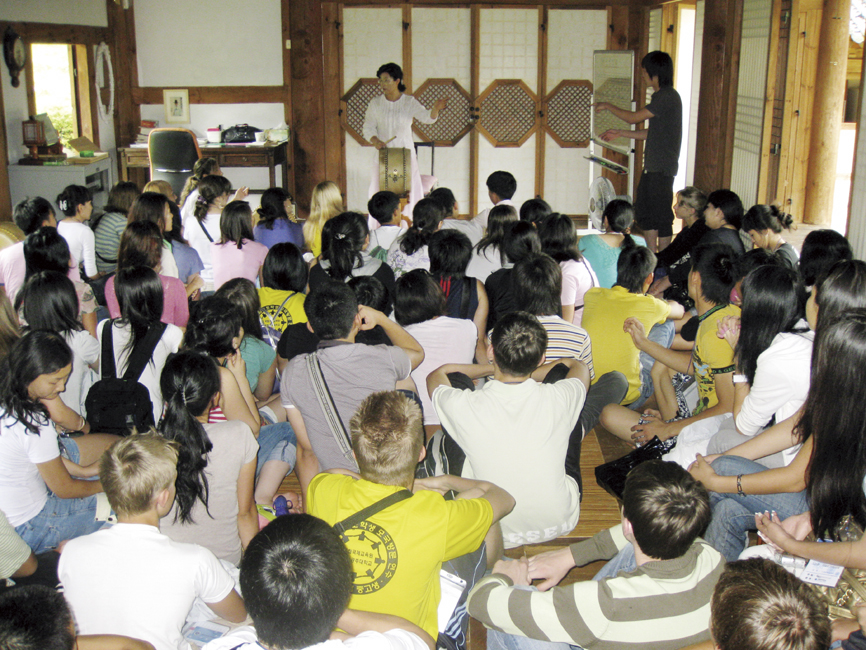About Chungnam
News
Enjoying Leisure in Gongju, The Old Capital of Baekje Dynasty
Taking a Journey Through Time to the History of 1,500 Years Ago
2011.01.04(화) | CNnews (![]() chungnamdo@korea.kr)
chungnamdo@korea.kr)
Into the History of 1,500 Years Ago
The Songsanri Tumuli is the collection of ancient tombs of kings and royal family members from the Baekje Woongjin Period, and comprises a total of seven tombs including the Tomb of King Muryeong (No. 7 of the Songsanri Tumuli), Historical Asset No. 13.

The Tomb of King Muryeong is made of bricks. After being discovered during a water pipe reparation at the No. 6 tomb in 1971, it had its 17 grave goods of 12 types appointed as a National Treasure. At the time of excavation, the bricks of the tomb, where the king and the queen were buried, bore lotus flower patterns. A detailed survey was done in 1997, and it was found that the leakage was serious and the tomb was closed for restoration. Tombs No. 5 and 6 were then reproduced in the model hall and put on display. They were made exactly the same size as the actual tombs. The exhibition hall also houses the models of the golden casket decorations, earrings, necklaces, and chignon ornaments excavated from the tombs. Also on display is the process of building the tomb. Any visitors can use the information system and portable guide, thus easily understanding the history of Baekje. Management Office(+82-41-840-2548)

Travel through Time at Gongju National Museum
Gongju National Museum houses the overall collections of artifacts from the Baekje Woongjin Period which will take you into the far reaches of distant history. It currently houses 16,000 artifacts excavated in Daejeon and Chungnam, and about 1,500 of them are categorized into significant items and on display at the Hall of the
Tomb of King Muryeong (Exhibition Hall 1) and Hall of Woongjin Culture (Exhibition Hall 2) including 19 pieces of National Treasure in 14 categories and 4 pieces of Treasure in 4 categories.

What attracts particular attention are the stone sculptures of imaginary animals, which are placed inside or in front of a tomb to repel evil ghosts. Also impressive are the Ring-pommeled Sword with a ring-shaped handle and the chicken-shaped kettle.

Gongju National Museum (+82-41-850-6300)
Gongsanseong Fortress Looking over Geumgang River
This is the mountain fortress that safeguarded the capital for 64 years over five generations from King Munju, who moved the capital here in the first year of his reign (475) to King Seong, who moved the capital again to Buyeo in the 16th year of his reign (538). Being a symbol of the Woongjin Period, it is also called Woongjin Fortress. It was made of earth during Baekje and renovated with stone during Joseon.
Although the mountain itself is not so high, there is a cliff on the riverside, which makes it an ideal stronghold. It stretches over 2,660m, 400m in the south and north and 800m in the east and west. It takes about 40~60 minutes to tour it. Inside the fortress are Geumseoru, Jinnamru, Gongbukru, Ssangsujeong, and Yeongeunsa.

At Geumseoru, you can watch the ceremony of the changing of the guard every weekend (11:00 am and 4:00 pm on Saturdays and Sundays). The program presents a marvelous reproduction of the guards who escorted the royal castle 1,500 years ago. Their costumes and props reproduced based on thorough historical research create quite a spectacle. You can also experience the Baekje costumes yourselves, becoming a king, queen, general, or guard. Information Office (+82-41-856-7700)
Tour of Museums in Gongju
Seokjangri Museum is Korea’s first museum devoted to the prehistoric age and tells the valuable fact that Korean history began in the Old Stone Age, when people started to settle in the land, rather than the Dangun Period (Bronze Age). The exhibition halls each have a theme such as nature (geological age), mankind (evolutionary process), life and culture. The museum creates a beautiful landscape in harmony with the Geumgang River flowing down. Seokjangri Museum (+82-41-840-2491)

Walking along the Geumgang River, you will encounter the Park Dong-jin Pansori Inheritance Center (Exhibition Hall of His Legacy) before reaching Seokjangri Museum. Master of Pansori, the late Mr. Park, set up the center to teach his pupils and pass down the life of Pansori. The center houses his sound books where he wrote down Saseols along with his favorite drums, drumsticks, and costumes. You can experience folk songs, Chang, and Janggu first-hand here, which is why it’s popular among foreign tourists. Pansori Inheritance Center (+82-41-856-7770)

Gongju also has other museums scattered around the city including Chungnam Forest Museum, Chungnam History Museum, and Natural History Museum of Mt. Gyeryong, through which it deserves its reputation as the city of education.
Tour of Buddhist Temples-You Can Also Have a Temple Stay
Gongju’s most prominent Buddhist temples are Magok, Donghak, and Gap Buddhist Temple. Magok Buddhist Temple is especially nice for a spring visit. The stream flowing around it looks like the Great Absolute. It’s also known for escaping from all the turmoil during Japanese Invasion of Joseon in 1592 and Korean War. The temple welcomes visitors as it has throughout its history.
The temple also runs a temple stay program every weekend for those taking a self-searching journey. The program gives them a chance to turn their lives around and offers them a variety of disciplinary and life methods, helping them get rid of any worldly thoughts from their minds. Have an escape from your busy daily life walking down the quiet forest lane, enjoy a cup of tea, or simply immerse yourself into the tranquility. Magok Buddhist Temple (+82-41-841-6226)

Rafting at Geumgang River
 |
||
You can go rafting at Daehak-2-ri, Tancheon-myeon, Gongju. You will steer the bamboo raft with a long stick and enjoy childhood fun for an hour. The cool wind that hits your face while crossing the river is awfully refreshing. (50,000 won per person) The foot of the mountain near Daehak-2-ri is home to a range of experiential events year-round. Lately the event of gathering wild edible herbs including fernbrakes has been popular. (Apply at +82-11-9880-5675)
Travel Memo
+How to Come Enter the Cheonan-Nonsan Express Way while running on Gyeongbu Express Way from Seoul; exit at Jeongan IC; take National Road No. 23 to enter Gongju downtown. Or you can take National Road No. 40 at Nam Gongju IC or National Road No. 32 at Yuseong IC on Honam Express Way. Major relics are within a 20-minute drive from the downtown. +Where to Rest There are many motels in the downtown area including Gongju Hanokchon (+82-41-840-2763), Geumgang River Tourist Hotel (+82-41-852-1071), Mt. Gyeryong Gap Buddhist Temple Youth Hostel (+82-41-856-4666), and Gongju Youth Hostel (+82-41-852-1212). There are also many accommodations at the Gap, Donghak, Shinwon and Magok Buddhist Temple areas.




